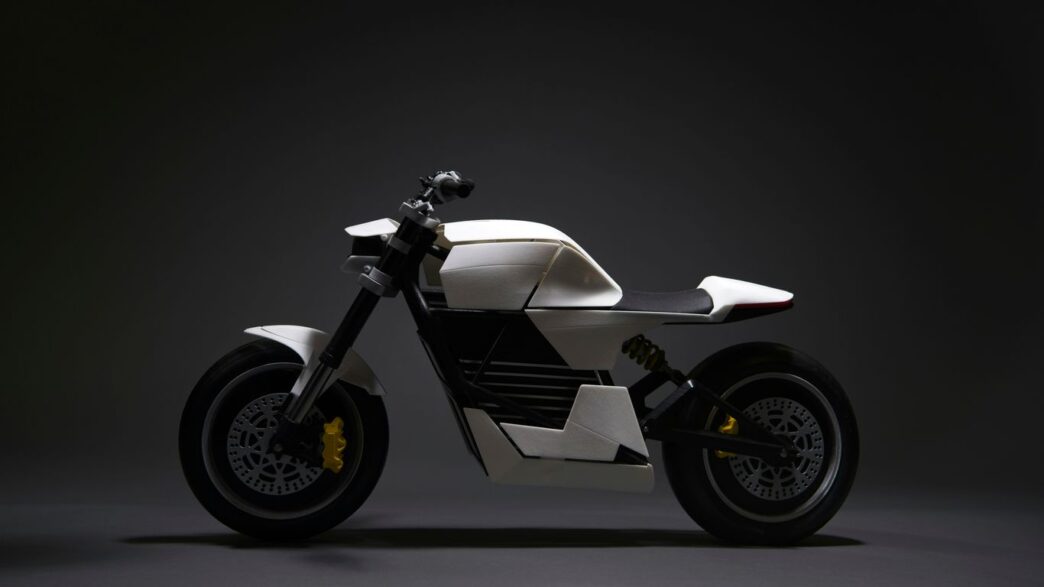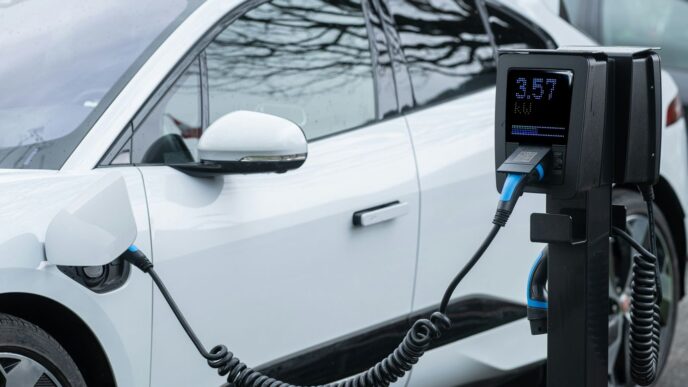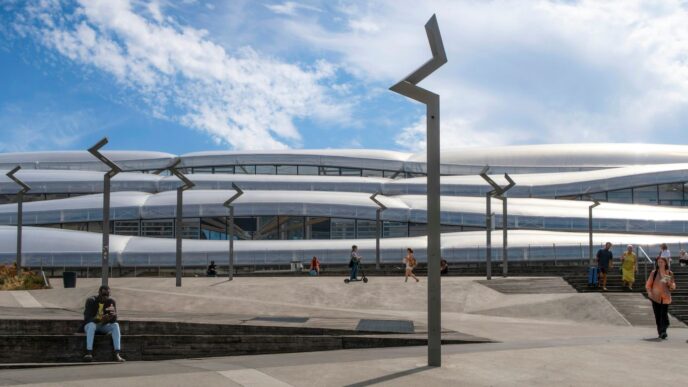Motorcycles have always been about freedom and the open road, right? Well, the future of riding is shaping up to be pretty interesting. We’re seeing a lot of changes, from how bikes are powered to how they connect with us and the world around them. It’s not just about going faster anymore; it’s about smarter, greener, and more personal ways to ride. Let’s take a look at what’s coming next in future motorcycle design.
Key Takeaways
- Electric power is becoming a big deal, with better batteries and charging making e-bikes more practical for longer rides.
- Smart tech is being added to bikes, like systems that help you ride safer and give you more info about your bike’s performance.
- Companies are starting to use more eco-friendly materials and manufacturing methods to make bikes better for the planet.
- Motorcycles are becoming more important for getting around cities, especially for quick deliveries and ride-sharing.
- Designers are mixing old-school looks with new technology, and riders are getting more options to customize their bikes to be unique.
The Electric Revolution In Future Motorcycle Design
It feels like electric motorcycles are finally moving beyond just being a cool idea and actually becoming a real thing you can buy and ride. For a long time, the big questions were about how far they could go on a single charge and how long it would take to refuel them, or rather, recharge them. But things are changing fast. Manufacturers are putting a lot of effort into making batteries better, and it’s paying off. We’re seeing bikes that can go over 200 miles now, which is pretty decent for most trips, even longer ones. Plus, charging times are getting shorter, which makes a big difference when you’re out and about.
Advancements in Battery Technology
This is where a lot of the magic is happening. The batteries themselves are getting more energy-dense, meaning they can hold more power in the same amount of space. This directly translates to longer ranges for the bikes. Think about it: a lighter battery that lasts longer is a win-win. We’re also seeing improvements in how quickly these batteries can be charged. Fast-charging stations are becoming more common, and the bikes themselves are getting better at accepting that quick jolt of power. It’s not quite as fast as filling up a gas tank, but it’s getting closer, and for many people, it’s already convenient enough.
Regenerative Braking Systems
This is a neat bit of tech that helps squeeze more miles out of the battery. Basically, when you brake or let off the throttle, the electric motor acts like a generator. It captures some of the energy that would normally be lost as heat and sends it back into the battery. It’s like getting a little bit of free energy back every time you slow down. This not only helps extend your range but also reduces wear on your traditional brakes. It’s a smart way to make the whole system more efficient.
The Rise of Electric Sportbikes
For a long time, electric bikes were often seen as more utilitarian or perhaps a bit quirky. But that’s changing, especially in the sportbike category. Companies are now building electric sportbikes that can really perform. They’re focusing on that instant torque that electric motors provide, which means incredible acceleration off the line. These bikes are designed to be fast, agile, and exciting to ride, proving that electric doesn’t mean sacrificing performance. The future of performance riding is looking decidedly electric.
Smart Technology Integration For Enhanced Riding
Motorcycles are getting a whole lot smarter, moving beyond just being a way to get around. It’s like they’re developing their own brains, making every ride safer and more connected. This isn’t just about fancy gadgets; it’s about making riding more intuitive and less stressful.
Intelligent Riding Assistants
Think of these as your co-pilot, but without the backseat driving. These systems learn how you ride. Over time, they can pick up on your habits and offer helpful nudges. Maybe it’s a suggestion to adjust your braking in a tricky corner or a heads-up about a potential hazard you might have missed. It’s all about personalized feedback to help you become a better, safer rider. They can even learn your preferred routes and suggest the best times to leave to avoid traffic.
IoT Connectivity and Performance Insights
Your bike is now talking to the world, and to you, in new ways. Through the Internet of Things (IoT), your motorcycle can share data about its performance, its health, and even its location. This means you can get detailed reports on your riding style, fuel efficiency, or how your engine is doing, all from an app on your phone. It’s like having a mechanic and a performance coach in your pocket. Some systems even allow for remote diagnostics, so if something’s up, the shop might know before you even notice.
Adaptive Cruise Control and Safety Systems
Remember when cruise control was just for cars? It’s showing up on bikes now, and it’s smarter than ever. Adaptive cruise control doesn’t just keep you at a set speed; it adjusts automatically to maintain a safe distance from the vehicle in front of you. If they slow down, you slow down. If they speed up, you speed up. Beyond that, we’re seeing more advanced safety nets. These can include things like blind-spot detection, which alerts you if there’s a vehicle in your blind spot when you’re thinking about changing lanes, or even automatic emergency braking systems that can help prevent or lessen the impact of a collision. It’s a big step towards making two-wheeled travel feel more secure.
Sustainable Materials And Eco-Conscious Manufacturing

It’s not just about going electric anymore; the whole manufacturing process is getting a green makeover. Think about it, building these machines has an impact, right? So, companies are really starting to look at what they use and how they make things.
Recyclable Materials in Construction
This is a big one. Instead of just using virgin plastics and metals that take a ton of energy to make and then just end up in a landfill, manufacturers are hunting for materials that can be recycled or are made from recycled stuff. We’re talking about things like recycled aluminum for frames, or plastics derived from old fishing nets or car parts. It’s not always easy, because motorcycle parts need to be tough and reliable, but they’re finding ways. Some frames might use advanced composites that are easier to break down and reuse later. Even the paint is getting a look-in, with water-based or low-VOC options becoming more common.
Reducing Waste in Production
Beyond the materials themselves, the factories are changing. Lean manufacturing principles are being applied more rigorously to cut down on scrap. This means optimizing how parts are cut from sheets of metal, reducing offcuts that would otherwise be thrown away. They’re also looking at energy use in the factory – using more renewable energy sources like solar panels on the roof, and making sure machinery is as efficient as possible. It’s a whole system approach to minimize the footprint.
Eco-Friendly Components
This goes beyond just the main structure. Think about the smaller bits and pieces. Lubricants are being developed that are biodegradable. Even the packaging for new bikes and parts is being rethought, moving away from excessive plastic wrap to more paper-based or reusable solutions. Some companies are even looking at the lifecycle of the battery in electric bikes, figuring out how to best recycle or repurpose them when they reach the end of their useful life in the vehicle. The goal is to make the entire journey of a motorcycle, from raw material to its eventual end-of-life, as gentle on the planet as possible.
The Evolving Role Of Motorcycles In Urban Mobility
Motorcycles are really changing how we get around in cities. It’s not just about the open road anymore; these two-wheelers are becoming super important for getting things done in busy urban areas.
Last-Mile Delivery Solutions
Think about all those packages and food orders zipping around town. Motorcycles and electric scooters are perfect for this. They can weave through traffic way better than big delivery vans, which means faster deliveries. Plus, they use less fuel and are cheaper to run. It’s a smart way to handle the final leg of delivery, especially when streets are jammed.
Motorcycle Ride-Sharing Platforms
This is a pretty cool idea that’s starting to pop up. Imagine needing a quick ride across town and being able to hop on the back of a motorcycle. These ride-sharing services can be faster and often cheaper than a car, especially in cities where traffic is a nightmare. Some places have even seen commute times drop significantly thanks to these services. It’s like a personal taxi, but on two wheels.
Lightweight Agility for City Commuting
For everyday folks just trying to get to work or run errands, lightweight motorcycles are becoming a big deal. They’re easy to handle in tight spots, simple to park, and they sip fuel. Bikes like the Honda Grom or Yamaha MT-03 are great examples. They offer that freedom of riding without the bulk of a bigger bike, making city travel a lot less stressful and more efficient.
Customization And Retro-Inspired Aesthetics
It feels like everyone wants their ride to be a little bit theirs, you know? And that’s totally happening with motorcycles right now. We’re seeing this cool mix where bikes look like they rolled right out of the 70s or 80s, but they’ve got all the modern tech tucked away inside. It’s like getting the best of both worlds – that classic vibe with all the conveniences we expect today.
Personalization Through Aftermarket Parts
This is where things get really interesting. Forget just picking a color; people are digging into the details. You can swap out exhausts for a different sound, change up the lighting to something unique, or even tweak the handlebars for a comfier or sportier feel. It’s not just about looks either; a lot of these aftermarket parts can actually change how the bike performs. Think custom seats that are way more comfortable for long rides, or different tire setups for better grip on certain roads. The goal is to make the bike a true reflection of the rider’s personality and needs.
Here’s a peek at what riders are commonly changing:
- Exhaust Systems: For a deeper rumble or a higher-pitched whine.
- Lighting: Swapping stock bulbs for LED kits, adding custom headlamps or tail lights.
- Seating: Custom upholstered seats, solo seats, or cafe racer humps.
- Handlebars & Controls: Different heights, widths, or styles like clip-ons or drag bars.
- Wheels & Tires: Changing the look and improving performance for specific riding conditions.
Blending Vintage Silhouettes with Modern Features
Manufacturers are catching on to this trend, too. They’re releasing new bikes that have that unmistakable retro charm – think sleek cafe racers, rugged scramblers, or classic bobbers. But under that vintage skin, they’re packing things like digital dashboards that look clean and simple, Bluetooth connectivity so you can hook up your phone, and sometimes even advanced rider aids that were unheard of on older bikes. It’s a smart move because it appeals to riders who love the old-school look but don’t want to give up modern comforts and safety.
Showcasing Unique Rider Builds
Social media has become a massive stage for this. You see riders sharing photos and videos of their custom bikes, and it’s seriously inspiring. There are whole communities built around sharing tips, tricks, and inspiration for DIY modifications. It’s not just about the big, expensive custom jobs either; it’s often the clever, smaller touches that really make a bike stand out. This whole culture of sharing and building together is really pushing the boundaries of what’s possible and making motorcycling feel more personal than ever.
Collaborative Innovation Driving Future Design
It’s pretty clear that the motorcycles of tomorrow aren’t going to be built by just one company in a vacuum. The really cool stuff, the kind that makes you go ‘wow,’ is happening when different industries decide to team up. Think about it: you’ve got folks who are amazing with materials, others who are wizards with software and AI, and then the motorcycle engineers who know how to put it all together. This cross-pollination of ideas is what’s really pushing the boundaries.
Cross-Industry Partnerships
We’re seeing motorcycle manufacturers working hand-in-hand with tech giants, material science labs, and even software developers. This isn’t just about slapping a new logo on something; it’s about combining specialized knowledge. For instance, a partnership might bring together a bike maker’s understanding of rider dynamics with an AI company’s ability to create smart systems. This could lead to things like riding assistants that actually learn how you ride and offer helpful, personalized tips, or safety systems that can predict and react to potential problems before you even see them.
Material Science Breakthroughs
Beyond the electronics, the very stuff motorcycles are made of is changing. Researchers are developing new composites and alloys that are lighter but stronger than what we’ve used before. Imagine a frame that’s significantly lighter, making the bike more agile and efficient, without sacrificing durability. This kind of progress often comes from collaborations between motorcycle companies and specialized material science firms. They’re not just looking for the next best metal; they’re exploring advanced polymers and even sustainable alternatives.
Bridging Technology and Engineering
Ultimately, it’s about making the whole package work better. This means taking cutting-edge tech, whether it’s a new battery chemistry or a sophisticated sensor array, and figuring out how to integrate it smoothly into a machine that’s fun and safe to ride. It’s a complex puzzle. You need engineers who understand the physics of a motorcycle and how a rider interacts with it, working closely with the people who design the electronic brains and the physical components. This synergy is key to creating motorcycles that are not just faster or more efficient, but genuinely smarter and more connected to the rider and their environment.
The Road Ahead
So, what does all this mean for the future of motorcycles? It’s pretty clear things are changing, and fast. We’re seeing a big push towards electric power, which is great for the planet, and honestly, some of those new electric bikes look pretty sweet. Plus, all the smart tech being added is making riding safer and maybe even a bit more fun. Whether you’re into classic looks with modern brains or rugged adventure machines, there’s going to be something for everyone. It feels like we’re on the edge of a whole new era for two-wheeled travel, and it’s going to be exciting to see where it all goes.
Frequently Asked Questions
What are the biggest changes coming to motorcycles?
Motorcycles are getting a major upgrade! We’re seeing more electric power, smarter technology to help riders, and a focus on using materials that are better for the planet. Think of them as becoming more like high-tech, eco-friendly machines.
Are electric motorcycles going to be common?
Yes, electric motorcycles are becoming a big deal. Batteries are getting better, meaning they can go further on a single charge. Plus, they’re quieter and better for the environment, which is why many companies are making them.
How will technology make riding safer?
New bikes will have smart features like systems that help you stay in your lane, alert you to danger, and even help you brake. Some bikes will even adapt their speed to the traffic ahead, making rides much safer, especially in busy areas.
Will motorcycles be used for more than just fun rides?
Definitely! Motorcycles are becoming super useful for getting around cities. They’re great for quick deliveries, like bringing food or packages, and you’ll see more services where you can hop on a motorcycle for a short trip, like a taxi.
Can I still make my motorcycle look unique?
Absolutely! Even with all the new tech, people still love to personalize their bikes. You’ll find lots of ways to add your own style with cool parts and custom paint jobs. Plus, designers are bringing back cool old-school looks with modern twists.
What are companies doing to make motorcycles environmentally friendly?
Manufacturers are working hard to be greener. They’re looking into using materials that can be recycled and trying to make the manufacturing process create less waste. This means future bikes will be kinder to the Earth.












